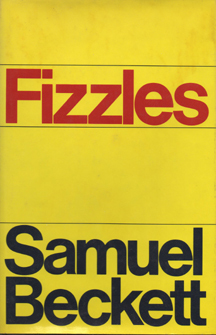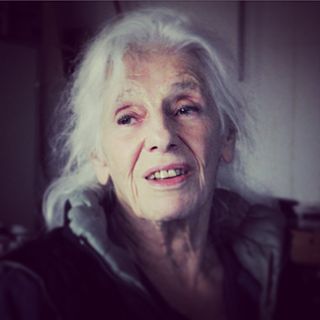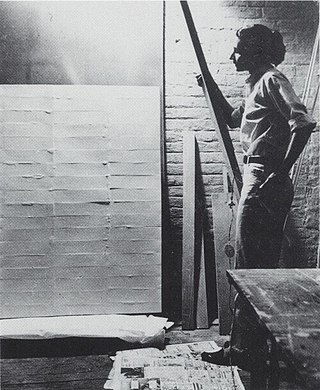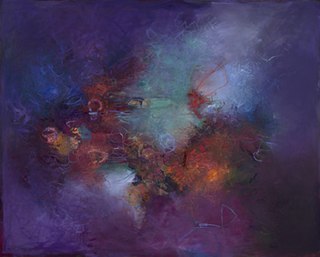
Helen Frankenthaler was an American abstract expressionist painter. She was a major contributor to the history of postwar American painting. Having exhibited her work for over six decades, she spanned several generations of abstract painters while continuing to produce vital and ever-changing new work. Frankenthaler began exhibiting her large-scale abstract expressionist paintings in contemporary museums and galleries in the early 1950s. She was included in the 1964 Post-Painterly Abstraction exhibition curated by Clement Greenberg that introduced a newer generation of abstract painting that came to be known as color field. Born in Manhattan, she was influenced by Greenberg, Hans Hofmann, and Jackson Pollock's paintings. Her work has been the subject of several retrospective exhibitions, including a 1989 retrospective at the Museum of Modern Art in New York City, and been exhibited worldwide since the 1950s. In 2001, she was awarded the National Medal of Arts.

Robert Delaunay was a French artist of the School of Paris movement; who, with his wife Sonia Delaunay and others, co-founded the Orphism art movement, noted for its use of strong colours and geometric shapes. His later works were more abstract. His key influence related to bold use of colour and a clear love of experimentation with both depth and tone.

Lenore "Lee" Krasner was an American Abstract Expressionist painter and visual artist active primarily in New York. She received her early academic training at the Women's Art School of Cooper Union, and the National Academy of Design from 1928 to 1932. Krasner's exposure to Post-Impressionism at the newly opened Museum of Modern Art in 1929 led to a sustained interest in modern art. In 1937, she enrolled in classes taught by Hans Hofmann, which led her to integrate influences of Cubism into her paintings. During the Great Depression, Krasner joined the Works Progress Administration's Federal Art Project, transitioning to war propaganda artworks during the War Services era.

Lyubov Sergeyevna Popova was a Russian-Soviet avant-garde artist, painter and designer.

Anne Truitt, born Anne Dean, was an American sculptor of the mid-20th century.
Paul Jenkins was an American abstract expressionist painter.
Shaped canvases are paintings that depart from the normal flat, rectangular configuration. Canvases may be shaped by altering their outline, while retaining their flatness. An ancient, traditional example is the tondo, a painting on a round panel or canvas: Raphael, as well as some other Renaissance painters, sometimes chose this format for madonna paintings. Alternatively, canvases may be altered by losing their flatness and assuming a three-dimensional surface. Or, they can do both. That is, they can assume shapes other than rectangles, and also have surface features that are three-dimensional. Arguably, changing the surface configuration of the painting transforms it into a sculpture. But shaped canvases are generally considered paintings.

The Fizzles are eight short prose pieces written by Samuel Beckett:

Elizabeth Murray was an American painter, printmaker and draughtsman. Her works are in many major public collections, including those of the Solomon R. Guggenheim Museum, the Hirshhorn Museum and Sculpture Garden, the Pérez Art Museum Miami, the Museum of Modern Art, the Whitney Museum of American Art, the San Francisco Museum of Modern Art, the Art Institute of Chicago, the Carnegie Museum of Art, and the Wadsworth Atheneum. Murray was known for her use of shaped canvases.

Josephine Gail Baer is an American painter associated with minimalist art. She began exhibiting her work at the Fischbach Gallery, New York, and other venues for contemporary art in the mid-1960s. In the mid-1970s, she turned away from non-objective painting. Since then, Baer has fused images, symbols, words, and phrases in a non-narrative manner, a mode of expression she once termed "radical figuration." She lives and works in Amsterdam, Netherlands.
Joe Goode is an American artist who attended the Chouinard Art Institute in Los Angeles from 1959–1961. Born in Oklahoma City, Oklahoma, Goode made a name for himself in Los Angeles through his cloud imagery and milk bottle paintings which were associated with the Pop Art movement. The artist is also closely associated with Light and Space, a West coast movement of the early 1960s. He currently creates and resides in Los Angeles, California.

Kathleen Kucka is an American visual artist whose practice includes abstract paintings, works on paper and prints. She is known for work that combines a conceptual approach with unique, sometimes unpredictable processes of mark-making such as the burning of canvas, pouring paint, and sewing. Critics note her work for its highly associative, open-ended quality, which evokes modernist formalism and natural phenomena from the microcosmic to the macrocosmic. Critic Stephanie Buhmann wrote that Kucka's work is inspired by nature and contemporary abstraction with attention to geometry, and leaves viewers "wondering if we are witnessing a scene documented through a microscope or captured from an aerial view ... we find ourselves reminded of the interrelations between all things, be they of a natural or man-made origin."

Eleanore Mikus was an American artist who began painting in the late 1950s in the Abstract Expressionist mode. By the early 1960s, she was creating monochromatic paintings with geometric patterns that according to Luis Camnitzer, “could be seen as conforming to the Minimalist aesthetic of the era while emphatically contradicting that style’s emotional distance and coldness.” In 1969, she began painting simple, cartoon-like images in bold, colorful strokes that anticipated Neo-Expressionism of the early 1980s. In the mid-1980s, Mikus resumed creating her abstract works. Since 1961, she has also been creating works of folded paper in which the “folds” make lines or textures that become integral to the material itself.
Squeak Carnwath is an American contemporary painter and arts educator. She is a professor emerita of art at the University of California, Berkeley. She has a studio in Oakland, California, where she has lived and worked since 1970.

20th-century Western painting begins with the heritage of late-19th-century painters Vincent van Gogh, Paul Cézanne, Paul Gauguin, Georges Seurat, Henri de Toulouse-Lautrec, and others who were essential for the development of modern art. At the beginning of the 20th century, Henri Matisse and several other young artists including the pre-cubist Georges Braque, André Derain, Raoul Dufy and Maurice de Vlaminck, revolutionized the Paris art world with "wild", multi-colored, expressive landscapes and figure paintings that the critics called Fauvism. Matisse's second version of The Dance signified a key point in his career and in the development of modern painting. It reflected Matisse's incipient fascination with primitive art: the intense warm color of the figures against the cool blue-green background and the rhythmical succession of the dancing nudes convey the feelings of emotional liberation and hedonism.

Howardena Pindell is an American artist, curator and educator. She is known as a painter and mixed media artist, her work explores texture, color, structures, and the process of making art; it is often political, addressing the intersecting issues of racism, feminism, violence, slavery, and exploitation. She is known for the wide variety of techniques and materials used in her artwork; she has created abstract paintings, collages, "video drawings," and "process art."

Agnes Weinrich was an American visual artist. In the early twentieth century, she played a critical role in introducing cubist theory to American artists, collectors, and the general public and became one of the first American abstractionists. A life-long proponent of modernist art, she was an active participant in the art communities of Provincetown and New York. Early in her career, she traveled widely in Europe and spent extended periods studying in Paris and Berlin. She also studied art in Chicago, Provincetown, and New York. During most of her career, she worked in a Provincetown studio during the warm months and a Manhattan studio during the cold ones. Weinrich's easel work included oil paintings, watercolors, and pastels. She also made block prints and etchings and drew using pencil and crayon. Her paintings, prints, and drawings appeared in solo and group exhibitions throughout her career and she received favorable critical attention both during her life and after her death.

Caroline Speare Rohland was an American artist and muralist who created three post office murals, as part of the art projects for the New Deal's Section of Painting and Sculpture. In addition to the three murals, Rohland has works in the permanent collections of the Library of Congress, The Honolulu Academy of Art, the New Mexico Museum of Art and the Whitney Museum of American Art.

Sigrid Burton is an American visual artist, known for semi-abstract paintings that combine atmospheric color fields and allusions to nature and culture. Her work bears a wide range of influences, including Buddhist cave and Indian miniature paintings, Jain cosmological diagrams, and artists from the Renaissance to modernists such as Kandinsky, Klee and the Color field painters to the California Light and Space movement. Critics have noted the predominance of color over form in her work, sometimes describing her approach as "chromatic expressionism."

Polly Hurry, was an Australian painter. She was a founding member of the Australian Tonalist movement and part of the Twenty Melbourne Painters Society.
















